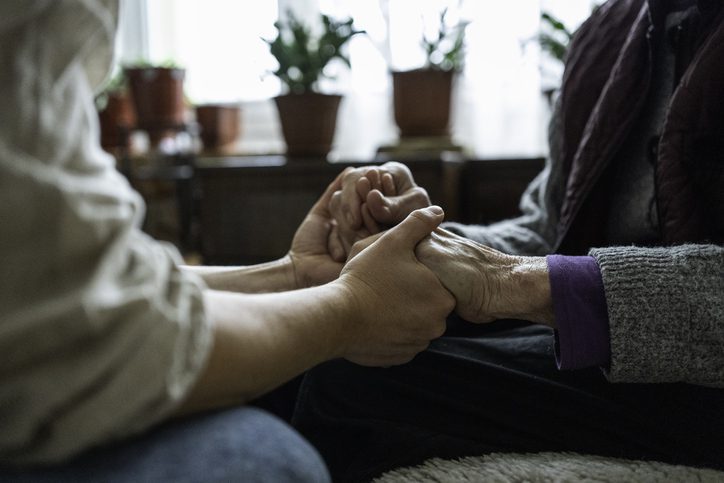If you’ve ever had to help clean out a family member’s home, you may already know it can be more than just a simple process of “moving stuff.” If there are excessive contents or the timeline for moving is short, the task may seem overwhelming.
Whether your loved one’s home is a small studio apartment or a large family estate with multiple outbuildings, helping a loved one manage their personal belongings is a huge job— it’s not just about the material possessions (although the heavy lifting is no small feat). The real heft comes from the memories and emotions attached to the physical items, which may have been accumulating for decades.
If you are cleaning house for an adult child with special needs, or have a complicated caregiving relationship with the person you’re assisting, this article is for you too.
First, we’ll break down the definition of hoarding disorder, then we’ll review the risks of excessive contents and provide tips for those who are assisting a loved one.
What is Hoarding Disorder?
It’s important to note there is a distinct difference between hoarding and collecting. Individuals that have lots of possessions aren’t necessarily hoarders. A person who has an extensive collection of valuable coins or antique mugs typically has these items organized, well-maintained and on display.
People who hoard may have collections among their possessions, but the items are typically disorganized and perhaps buried by the clutter of everyday things like stacks of newspapers, mail or unopened, spoiled food.
According to the Association for Behavioral and Cognitive Therapies (ABCT), true hoarding disorder includes each of these characteristics:
- A person collects and keeps items that appear useless or of little value to most people.
- A person’s living spaces are cluttered by these items and restrict the intended use of those spaces (i.e., they can’t sleep in bed because it’s stacked with stuff).
- The items cause challenges and distress in daily life activities.
Hoarding as a diagnosed mental health disorder is actually quite rare. Experts say the prevalence of hoarding disorder (HD) varies widely, from 2 percent to 6 percent of the general population.
The rates of HD are higher among those over age 60, particularly those who have other mental health diagnoses like anxiety, depression, ADHD or obsessive-compulsive disorder (OCD). In some cases, dementia or stroke may contribute to hoarding behaviors.
Both men and women are affected equally, and hoarding behaviors begin early in life, increasing in severity with each decade of life. The exact cause is unknown, but it’s generally the result of several factors, including genetics, brain function, and stressful life events, such as the death of a loved one, according to Mayo Clinic.
How Hoarding Affects Caregiving
Hoarding disorder is a complicated mental health issue. It also has a significant effect on caregiving due to the health risks faced by someone living with excessive contents (including falls, illnesses, and isolation)—and because of the relationship challenges that often go with it.
Being a caregiver attempting to keep another person safe, healthy, and independent can be a difficult role.
You might walk into a loved one’s house, for example, and feel confused by the amount of things. It’s normal to feel overwhelmed by the sheer quantity and emotional quality of the items, and possibly saddened by the state of their living situation.
These feelings are valid responses to the task ahead. Allowing yourself to feel those emotions instead of ignoring them may make coping with the situation easier.
The Health and Financial Risks of Excessive Contents
Before launching into practical tips for managing a potential hoarding situation, it’s helpful to understand the health and financial risks of hoarding. These facts may be useful in helping the person with excessive contents (or any family members who have questions about the situation) to understand why it’s necessary to take action.

According to experts at The Hartford, hoarding has emerged as a more frequent cause of loss and a major factor in loss severity. That means claims associated with excessive contents are more severe for the customer and more costly for the insurer.
Here are several ways that excessive contents can put people at risk:
- Liability. A caregiver, visitor, or the person living in the home could trip and fall, causing injury. Plus, if the person struggles to find their glasses or perhaps mobility aids, falls may be more likely to occur.
- Mold exposure. This can lead to illness or infection, either acute or chronic. If the refrigerator is full of expired food and drinks, for example, mold may be ingested simply by consumption, causing severe illness.
- Fire hazards. Combustible items (paint thinners, Sterno fuel, candles, etc.) or unsafe item storage (i.e., stacks of brown paper bags and old newspapers kept near the stove) can create fire risks.
- Blocked exits. If exits and entrances are blocked, emergency personnel may not be able to move as quickly or efficiently.
- Water leaks: A leak in a severely cluttered home may go unnoticed for a while, leading to total loss and delayed mold mitigation and water damage remediation.
Be sure to check your loved one’s home insurance coverage to make sure they have the protection they need for peace of mind at home.
Tips for Navigating an Excessive Contents Clean-out
Go into this process with an open mind and compassionate heart. Remember there are deeper reasons for your loved one’s accumulation of items; try to see the situation through their eyes.
To conserve your own emotional energy throughout this process, do your best to separate yourself from the person’s internal struggle. Give grace for the grief—yours and theirs—that may come.
Work with a therapist to cope with the feelings this process brings up for you, if needed.
Moving a person late in their lives—or cleaning out a home after someone has passed away—can be an intensely emotional process. There may be tears, expletives, and arguments. But there is also the potential for joy.
Take time to listen and really hear what matters most to the loved one you’re helping. Ask them to share stories from their life while you work through the home.

Be respectful of any legitimate collections versus “hoarded” ones. Focus on preserving the things that are truly meaningful to the individual.
Play music to lighten the mood. We’ve already made a spring cleaning playlist for you!
Try not to take on too much; pace yourself as time and resources allow. The pressure of a deadline exacerbates the stress of the process.
Do not attempt to do this alone. Enlist friends and family who may not be as emotionally connected to the process. Delegate, delegate, delegate—and don’t feel guilty for doing so.
Come up with a room-by-room action plan with help from our article on Cleaning Out a Loved One’s Home.
Bonus tip: Perhaps helping someone else through this process has opened your eyes to your own struggles with managing the contents of your house. Consider reading “How to Keep House While Drowning: A Gentle Approach to Cleaning and Organizing” by KC Davis. This book can help you adopt a more compassionate mindset toward your own challenges and prevent the accumulation of clutter in your home.







I am a clinical social worker who works with caregivers as well as clients affected by hoarding. In addition, I have friends who hoard. With caregivers, this begins with educating them about the disorder and differentiating between what they perceive and how the relative sees the objects. I help them to identify their stress and manage the stress as well as determine their emotional relationship with the client. I teach them how to communicate with individual and to begin with small removal of objects and to assess the person’s safety and mental clarity and health condition. They must learn to cope with their frustration with the degree of change the person is willing to make. I recommend patience as well enlisting support from others who can understand and help. Sometimes the hoarding is life-long while other times it develops with life transitions such as retirement and death of a love one.